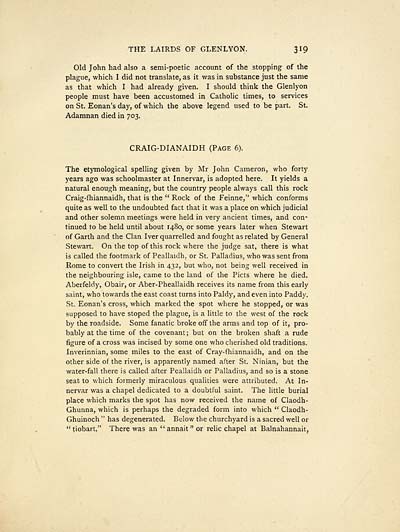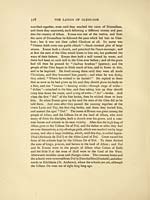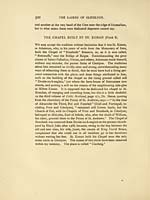Lairds of Glenlyon
(331) Page 319
Download files
Complete book:
Individual page:
Thumbnail gallery: Grid view | List view

THE LAIRDS OF GLENLYON. 319
Old John had also a semi-poetic account of the stopping of the
plague, which I did not translate, as it was in substance just the same
as that which I had already given. I should think the Glenlyon
people must have been accustomed in Catholic times, to services
on St. Eonan's day, of which the above legend used to be part. St.
Adamnan died in 703.
CRAIG-DIANAIDH (Page 6).
The etymological spelling given by Mr John Cameron, who forty
years ago was schoolmaster at Innervar, is adopted here. It yields a
natural enough meaning, but the country people always call this rock
Craig-fhiannaidh, that is the " Rock of the Feinne," which conforms
quite as well to the undoubted fact that it was a place on which judicial
and other solemn meetings were held in very ancient times, and con-
tinued to be held until about 1480, or some years later when Stewart
of Garth and the Clan Iver quarrelled and fought as related by General
Stewart. On the top of this rock where the judge sat, there is what
is called the footmark of Pea.llaidh. or St. Palladius, who was sent from
Rome to convert the Irish in 432, but who, not being well received in
the neighbouring isle, came to the land of the Picts where he died.
Aberfeldy, Obair, or Aber-Pheallaidh receives its name from this early
saint, who towards the east coast turns into Paldy, and even into Paddy.
St. Eonan's cross, which marked the spot where he stopped, or was
supposed to have stoped the plague, is a little to the west of the rock
by the roadside. Some fanatic broke off the arms and top of it, pro-
bably at the time of the covenant; but on the broken shaft a rude
figure of a cross was incised by some one who cherished old traditions.
Inverinnian, some miles to the east of Cray-fhiannaidh, and on the
other side of the river, is apparently named after St. Ninian, but the
water-fall there is called after Peallaidh or Palladius, and so is a stone
seat to which formerly miraculous qualities were attributed. At In-
nervar was a chapel dedicated to a doubtful saint. The little burial
place which marks the spot has now received the name of Claodh-
Ghunna, which is perhaps the degraded form into which " Claodh-
Ghuinoch " has degenerated. Below the churchyard is a sacred well or
"tiobart," There was an " annait " or relic chapel at Balnahannait,
Old John had also a semi-poetic account of the stopping of the
plague, which I did not translate, as it was in substance just the same
as that which I had already given. I should think the Glenlyon
people must have been accustomed in Catholic times, to services
on St. Eonan's day, of which the above legend used to be part. St.
Adamnan died in 703.
CRAIG-DIANAIDH (Page 6).
The etymological spelling given by Mr John Cameron, who forty
years ago was schoolmaster at Innervar, is adopted here. It yields a
natural enough meaning, but the country people always call this rock
Craig-fhiannaidh, that is the " Rock of the Feinne," which conforms
quite as well to the undoubted fact that it was a place on which judicial
and other solemn meetings were held in very ancient times, and con-
tinued to be held until about 1480, or some years later when Stewart
of Garth and the Clan Iver quarrelled and fought as related by General
Stewart. On the top of this rock where the judge sat, there is what
is called the footmark of Pea.llaidh. or St. Palladius, who was sent from
Rome to convert the Irish in 432, but who, not being well received in
the neighbouring isle, came to the land of the Picts where he died.
Aberfeldy, Obair, or Aber-Pheallaidh receives its name from this early
saint, who towards the east coast turns into Paldy, and even into Paddy.
St. Eonan's cross, which marked the spot where he stopped, or was
supposed to have stoped the plague, is a little to the west of the rock
by the roadside. Some fanatic broke off the arms and top of it, pro-
bably at the time of the covenant; but on the broken shaft a rude
figure of a cross was incised by some one who cherished old traditions.
Inverinnian, some miles to the east of Cray-fhiannaidh, and on the
other side of the river, is apparently named after St. Ninian, but the
water-fall there is called after Peallaidh or Palladius, and so is a stone
seat to which formerly miraculous qualities were attributed. At In-
nervar was a chapel dedicated to a doubtful saint. The little burial
place which marks the spot has now received the name of Claodh-
Ghunna, which is perhaps the degraded form into which " Claodh-
Ghuinoch " has degenerated. Below the churchyard is a sacred well or
"tiobart," There was an " annait " or relic chapel at Balnahannait,
Set display mode to:
![]() Universal Viewer |
Universal Viewer | ![]() Mirador |
Large image | Transcription
Mirador |
Large image | Transcription
Images and transcriptions on this page, including medium image downloads, may be used under the Creative Commons Attribution 4.0 International Licence unless otherwise stated. ![]()
| Histories of Scottish families > Lairds of Glenlyon > (331) Page 319 |
|---|
| Permanent URL | https://digital.nls.uk/95358871 |
|---|
| Description | A selection of almost 400 printed items relating to the history of Scottish families, mostly dating from the 19th and early 20th centuries. Includes memoirs, genealogies and clan histories, with a few produced by emigrant families. The earliest family history goes back to AD 916. |
|---|

